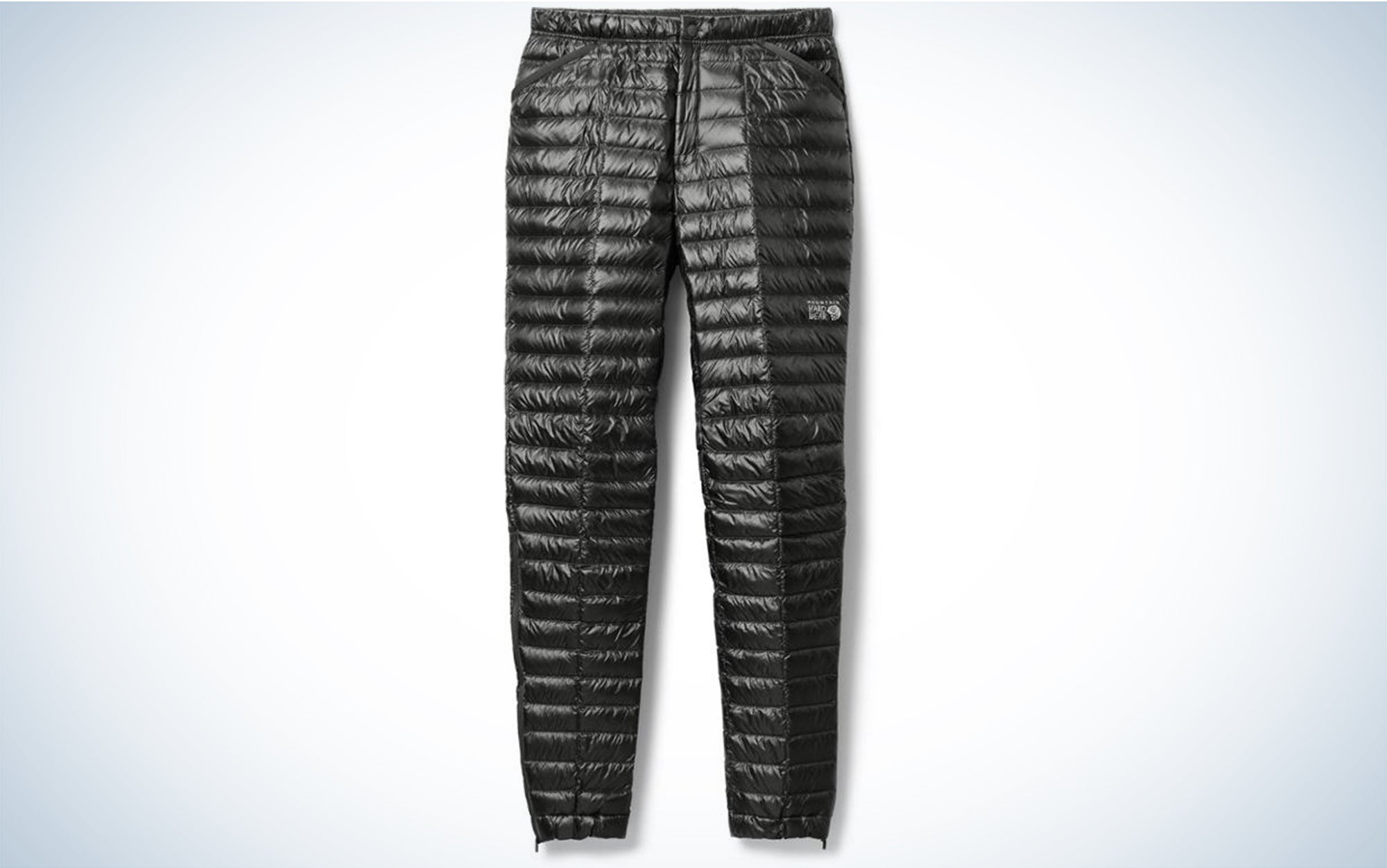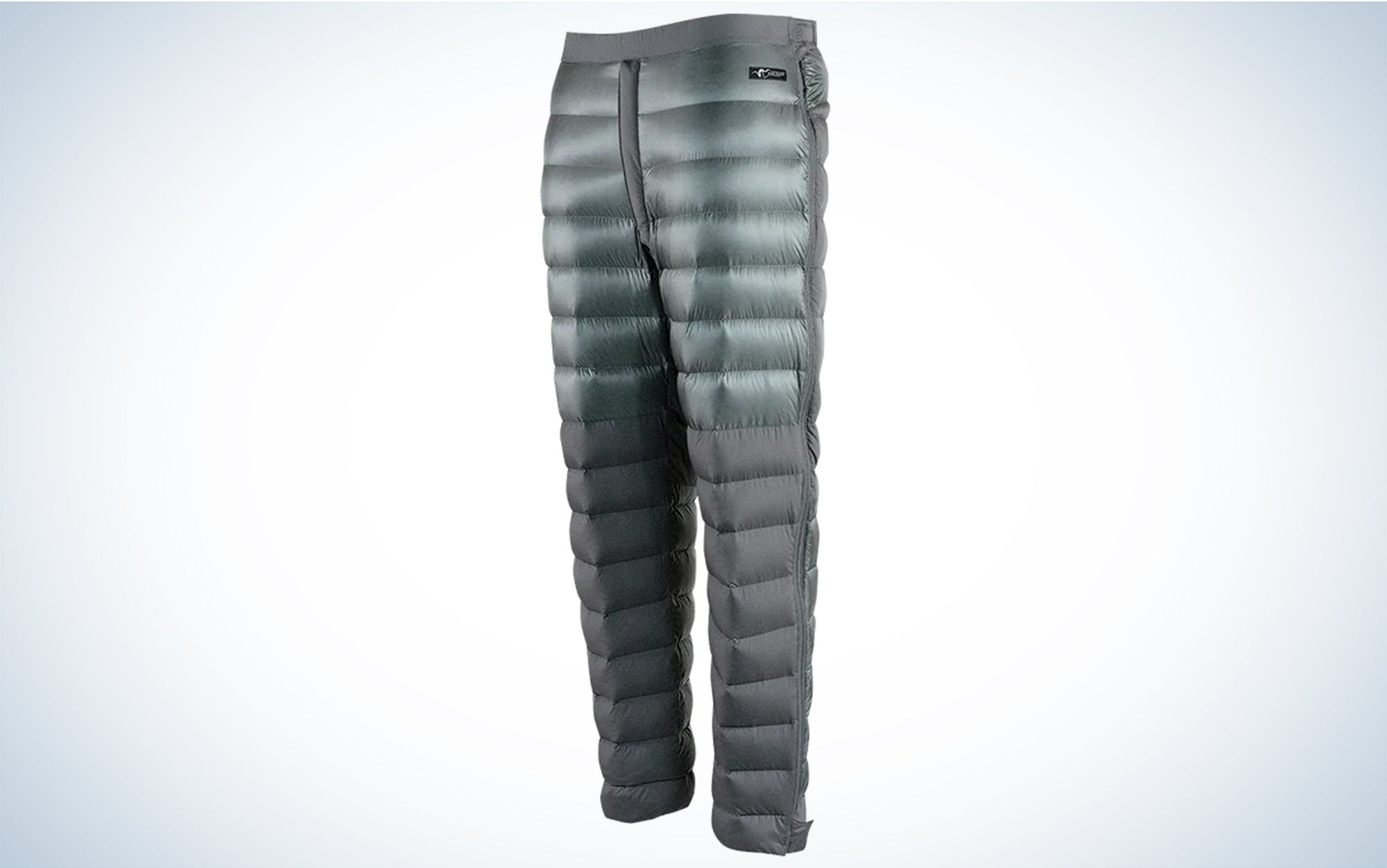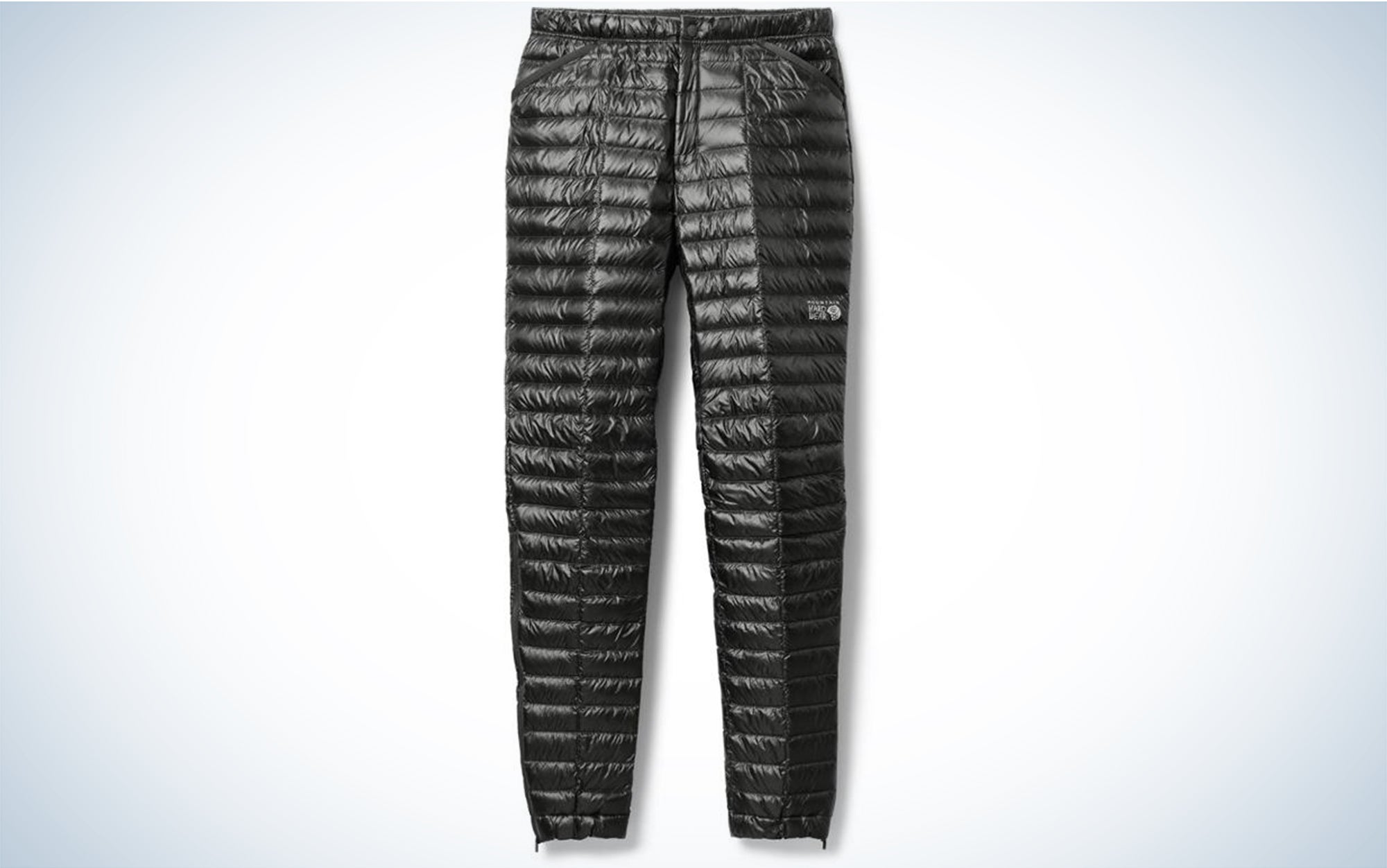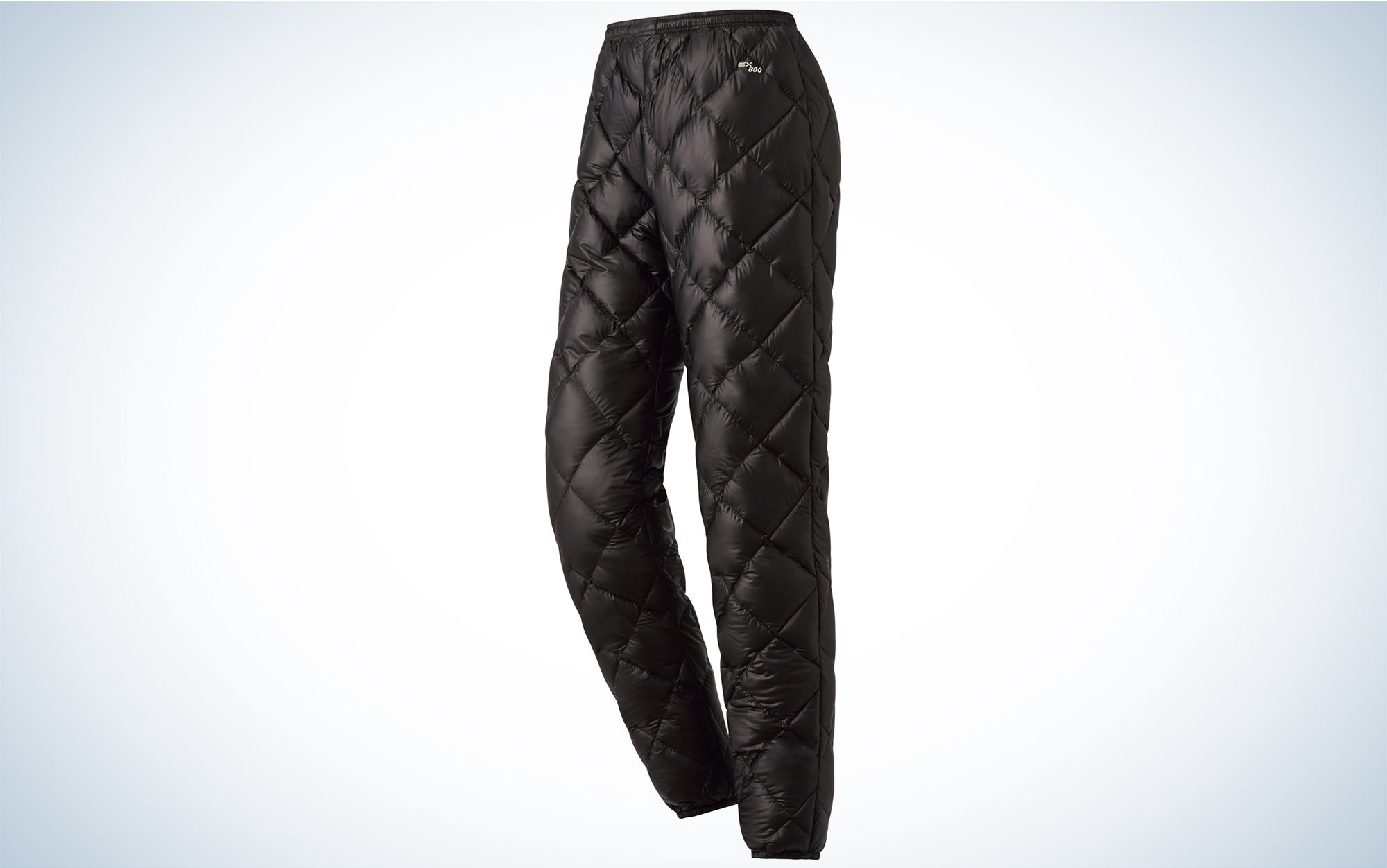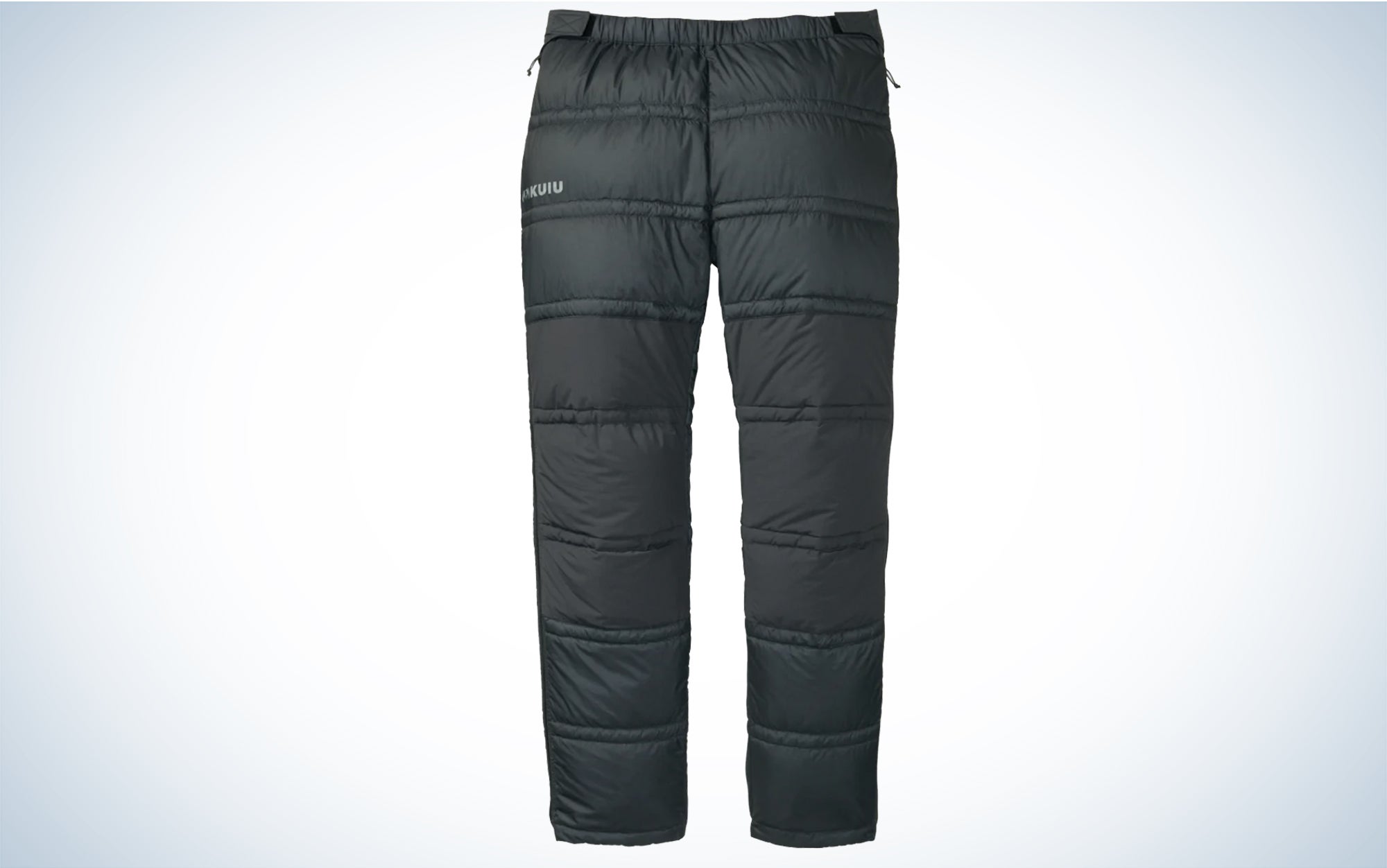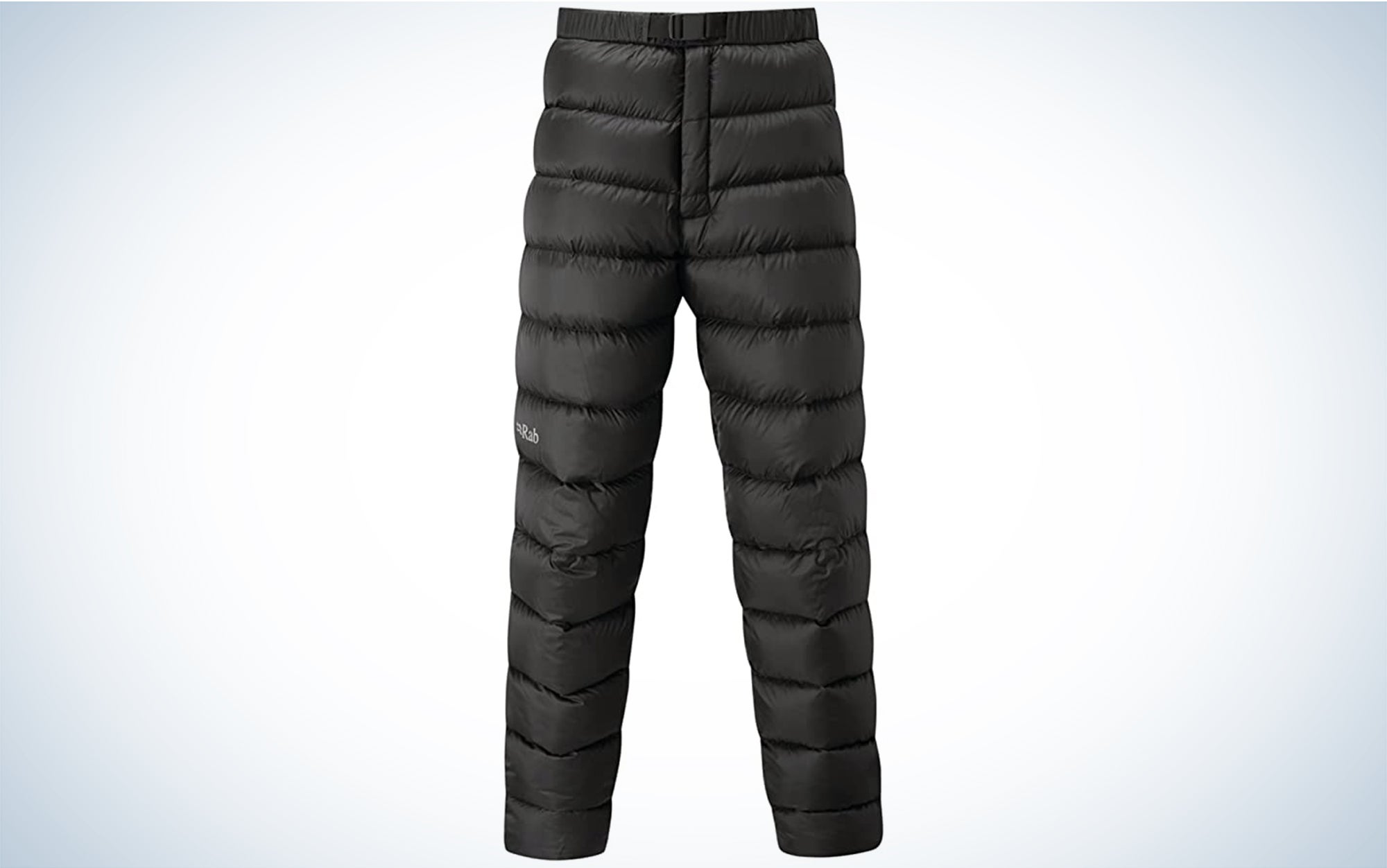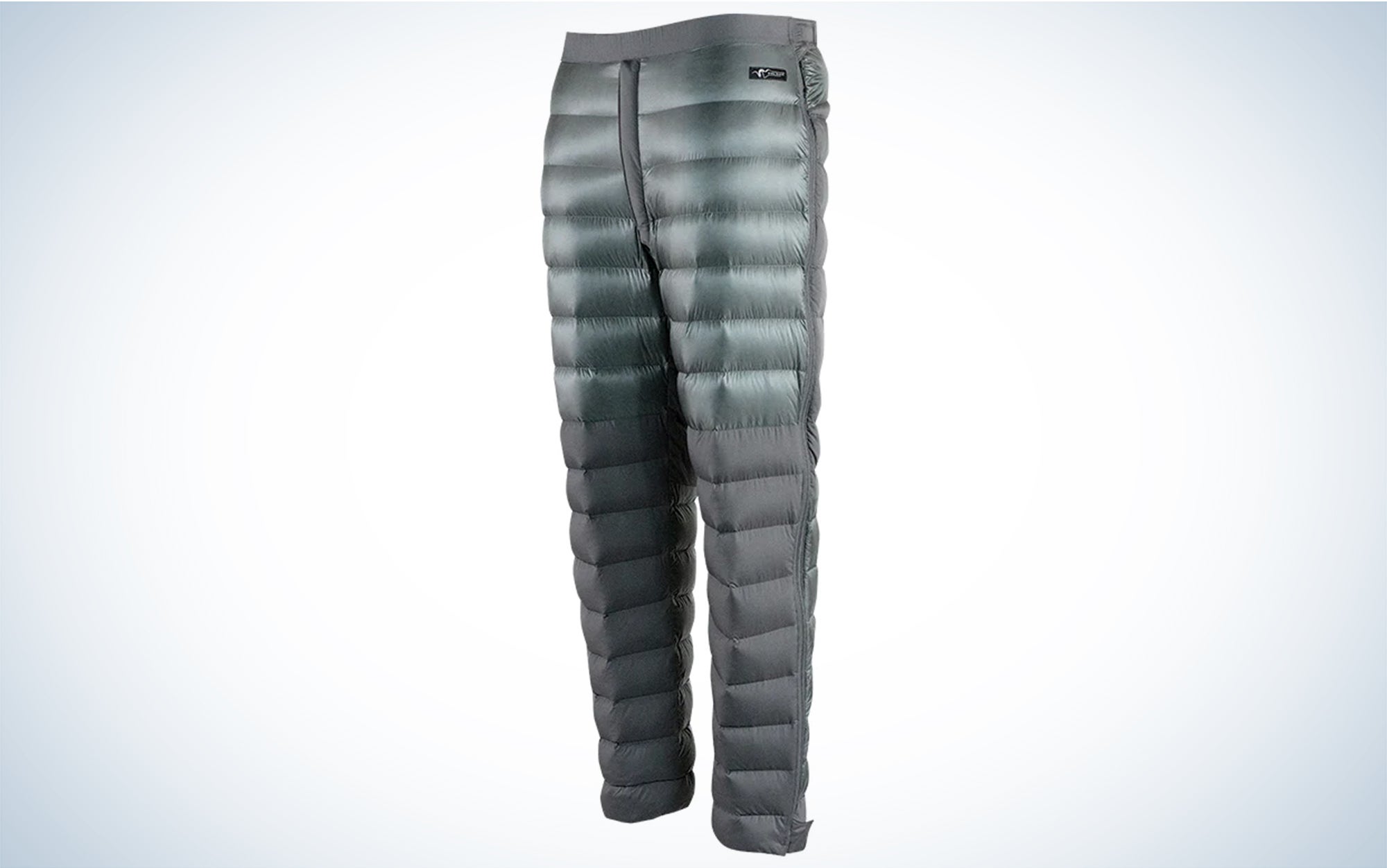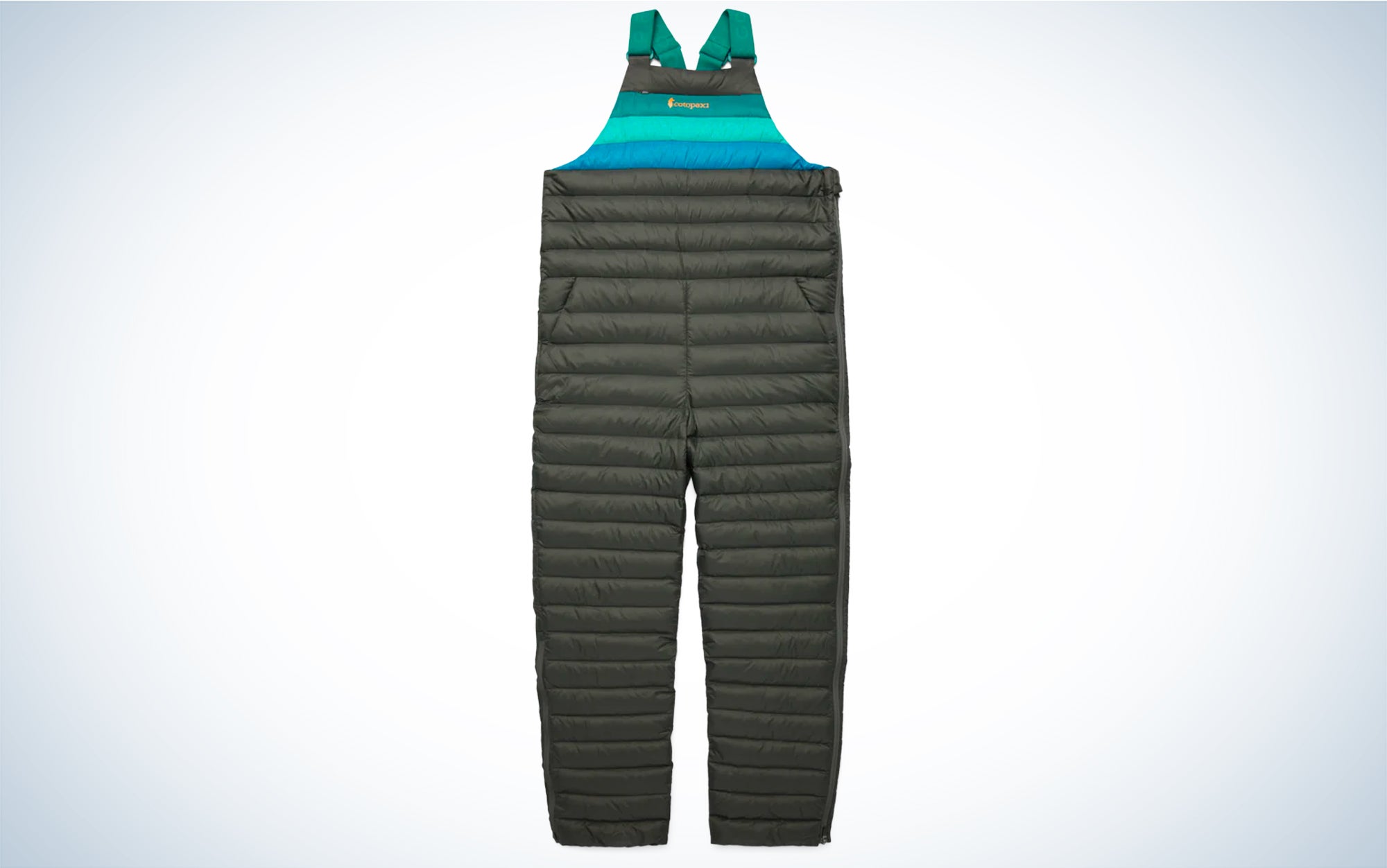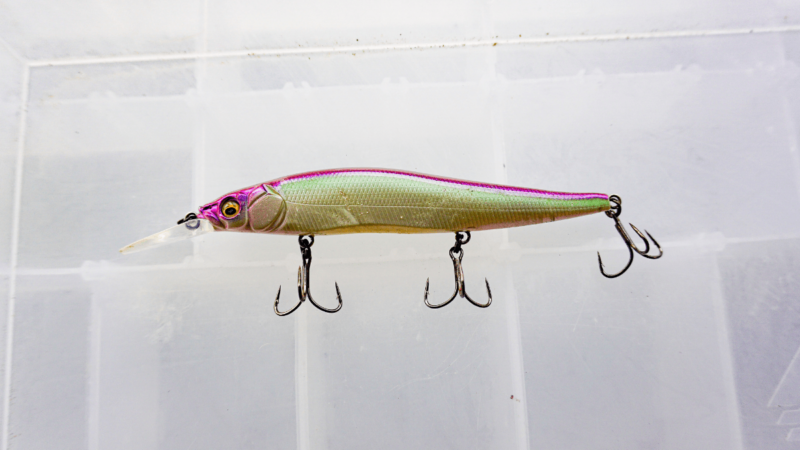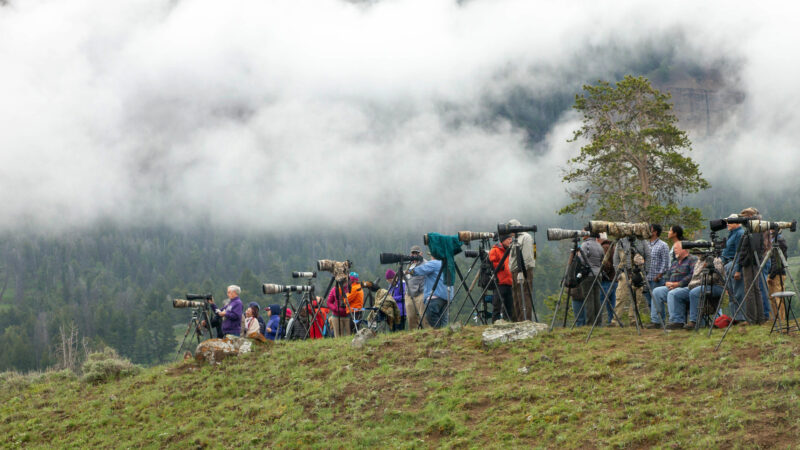The Best Puffer Pants of 2023: Tested and Reviewed
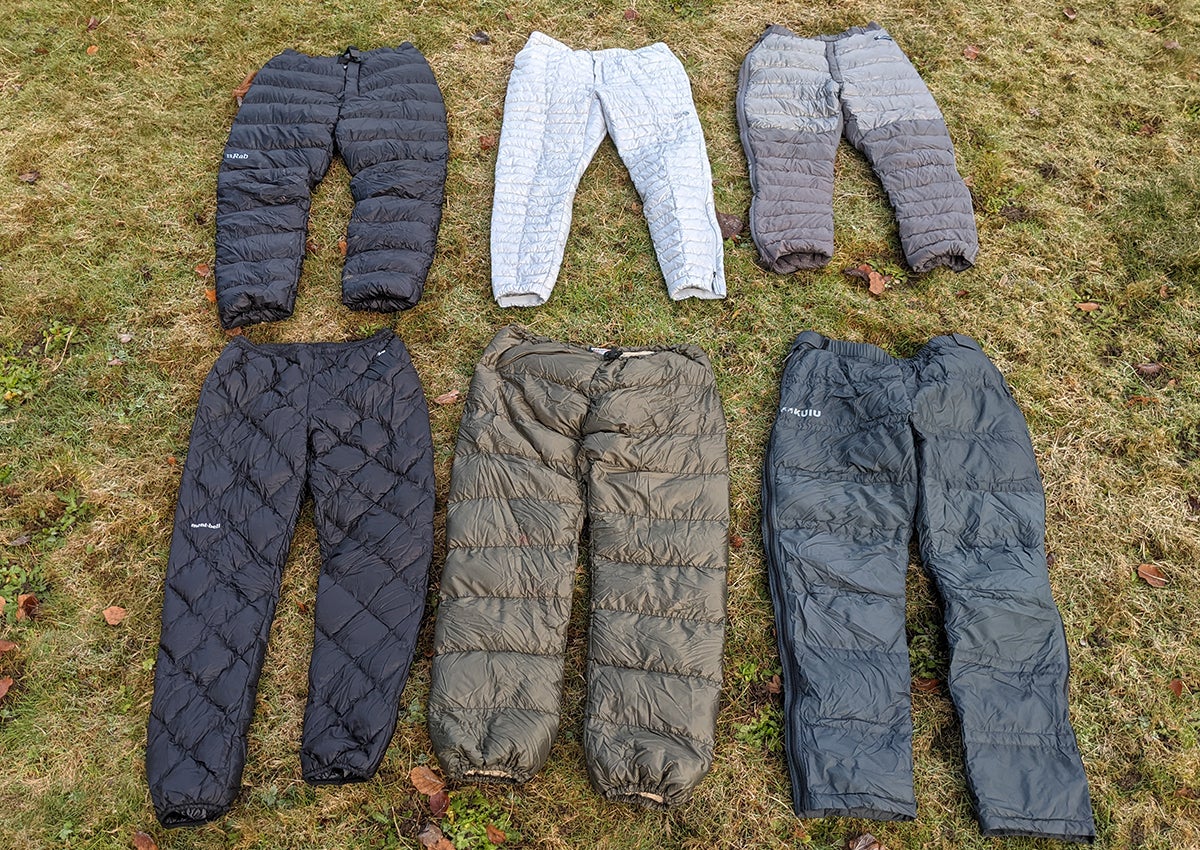
We may earn revenue from the products available on this page and participate in affiliate programs. Learn More ›
Sure, those fleece-lined jeans and wool baselayers might have kept you warm during the early shoulder season, but as soon as sub-freezing temps hit you’re going to wish you had a more serious layer. That means insulated down pants. That’s right, the same down that keeps your upper body warm can be used for your lower half as well. To find the best puffer pants, we took down-filled models from Mountain Hardwear, Rab, Stone Glacier, Montbell, Goosefeet Gear, and KUIU out into the field to put them to the test.
- Best Overall: Mountain Hardwear Ghost Whisperer
- Best Ultralight: Montbell Light Down Pants
- Best for Scouting: KUIU Super Down ULTRA Pant
- Best Customization: Goosefeet Gear Down Pants
- Best for Winter: Rab Argon Down Pants
- Best for Hunting: Stone Glacier Grumman Down Pant
- Best Bib: Cotopaxi Fuego Down Overall
How I Tested Puffer Pants
Puffer pants were tested in a number of environments, including by members of the Outdoor Life team during a December deer hunt in Missouri. We wore the puffy pants on mile-long scouting treks on public land, at the gun range during target practice, and while sitting in deer stands in both late afternoon and early morning hours, when temperatures dipped well below freezing. Insulated pants were evaluated on their comfort, fit, warmth, and overall functionality.
| Puffer Pants | Price | Available Sizes | Weight | Shell Fabric | Fill power | Fill weight |
| Mountain Hardwear Ghost Whisperer | $275 | Men’s S-XXL Women’s XS-XL |
9.6 oz | 15D ripstop nylon | 800fp | unavailable |
| Rab Argon Down Pant | $210 | Men’s XS-XXL | 13.2 oz | Pertex, 20D nylon | 800fp | 5.6 oz |
| Cotopaxi Fuego Down Overall | $285 | Men’s S-XXL | 14 oz. | 20D nylon | 800fp | unavailable |
| Stone Glacier Grumman Down Pant | $250 | Men’s S-XXL | 16 oz | 15D Pertex | 850fp | 4.2 oz |
| Goosefeet Gear Down Pants | $170 | Customizable | N/A | 8D or 20D | 850fp | 2.5 to 8.5 oz |
| Montbell Light Down Pants | $230 | Men’s S-XXL Women’s S-XL |
7.1 oz | 10D ripstop nylon | 800fp | 3 oz |
| KUIU Super Down ULTRA Pant | $260 | Men’s M-XXXL | 8 oz | 12D ripstop | 850fp | 1.7 oz |
In addition, I also considered how the fill power and fill weight of each pair of down pants balanced warmth with layerability, as well as other features, such as closure mechanisms and side zippers. Finally, I looked at the packed size and weight of each pair.
The Best Puffer Pants: Reviews & Recommendations
Best Overall: Mountain Hardwear Ghost Whisperer Pant
Mountain Hardwear
Key Features
- Available Sizes: Men’s S-XXL; women’s XS-XL
- Weight: 9.6 ounces
- Fill Power: 800fp
- Fill Weight: Unavailable
- Shell Material: 15D ripstop nylon
Pros
- Different inseam measurements available
- Only down pants in my test with pockets
- Lightweight
- Can be taken on and off without removing shoes
Cons
- Expensive
- Not as warm as other puffer pants in my test
The corollary to the Mountain Hardwear Ghost Whisperer—one of the best puffer jackets around—is this pair of deceptively simple puffer pants. While at first glance, they looked like nothing more than a pair of puffy tubes, this one excels in the details. With an elastic waist and a snap-button and zip closure, this one pulls on more like a typical pair of pants than others I looked at. The Ghost Whisperer was also the only pair to include pockets—handy if you are pulling it on directly over your other clothing as the evening temps drop. Zips at the cuff that run halfway up the calf help you to pull it on over (some) boots without having to take them off.
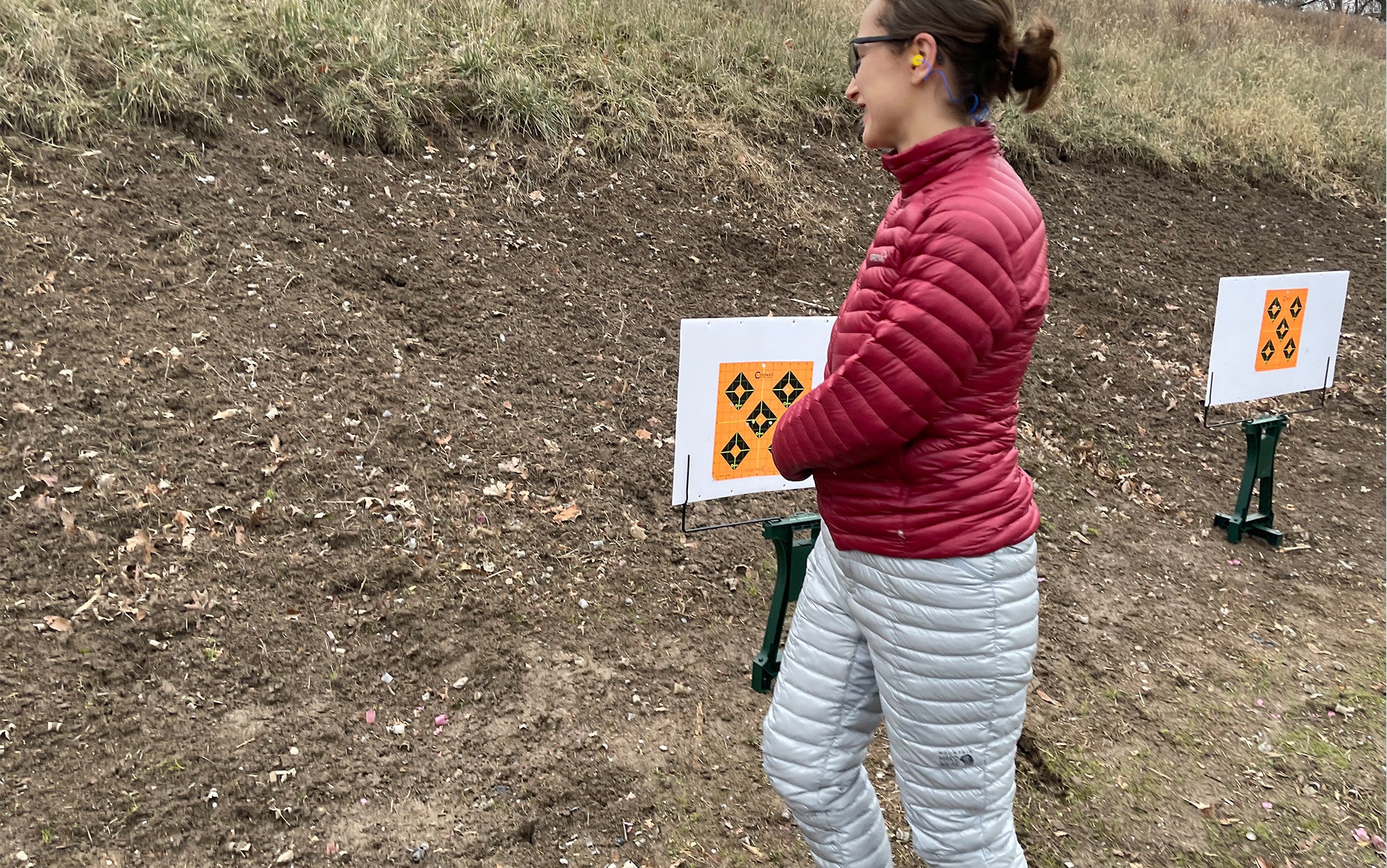
Like the jacket it gets its name from, this is not an exceptionally warm pair of insulated pants—it’s a middle of the road puffer, best suited for summer alpine or early shoulder season activities unless you plan to wear it only while hiking or run especially warm. What it is, however, is lightweight—only a couple of ounces more than my best ultralight pick, the Montbell Light Down Pants, which has far fewer features.
Best Ultralight: Montbell Light Down Pants
Montbell
Key Features
- Available Sizes: Men’s S-XXL; women’s S-XL
- Weight: 7.1 ounces
- Fill Power: 850fp
- Fill Weight: 3 ounces
- Shell material: 10D ripstop nylon
Pros
- Lightweight but durable
- Small packed size
- Slim profile layers well under shell pants
Cons
- Run small
- Not warm enough for winter conditions
At 7.1 ounces, the Montbell Light Down Pants are the perfect fit for early-season backpackers and alpine adventurers. I’ve carried earlier versions of the Montbell Light Down Pants everywhere from the High Sierras to the North Cascades and never once regretted the extra weight in my pack. The three ounces of 800 fill power down is enough to keep you warm in 30-degree temps in the evening (or 20-degree temps if you’re on the go), while still compressing down to about the size of a pair of socks in your bag when not in use.
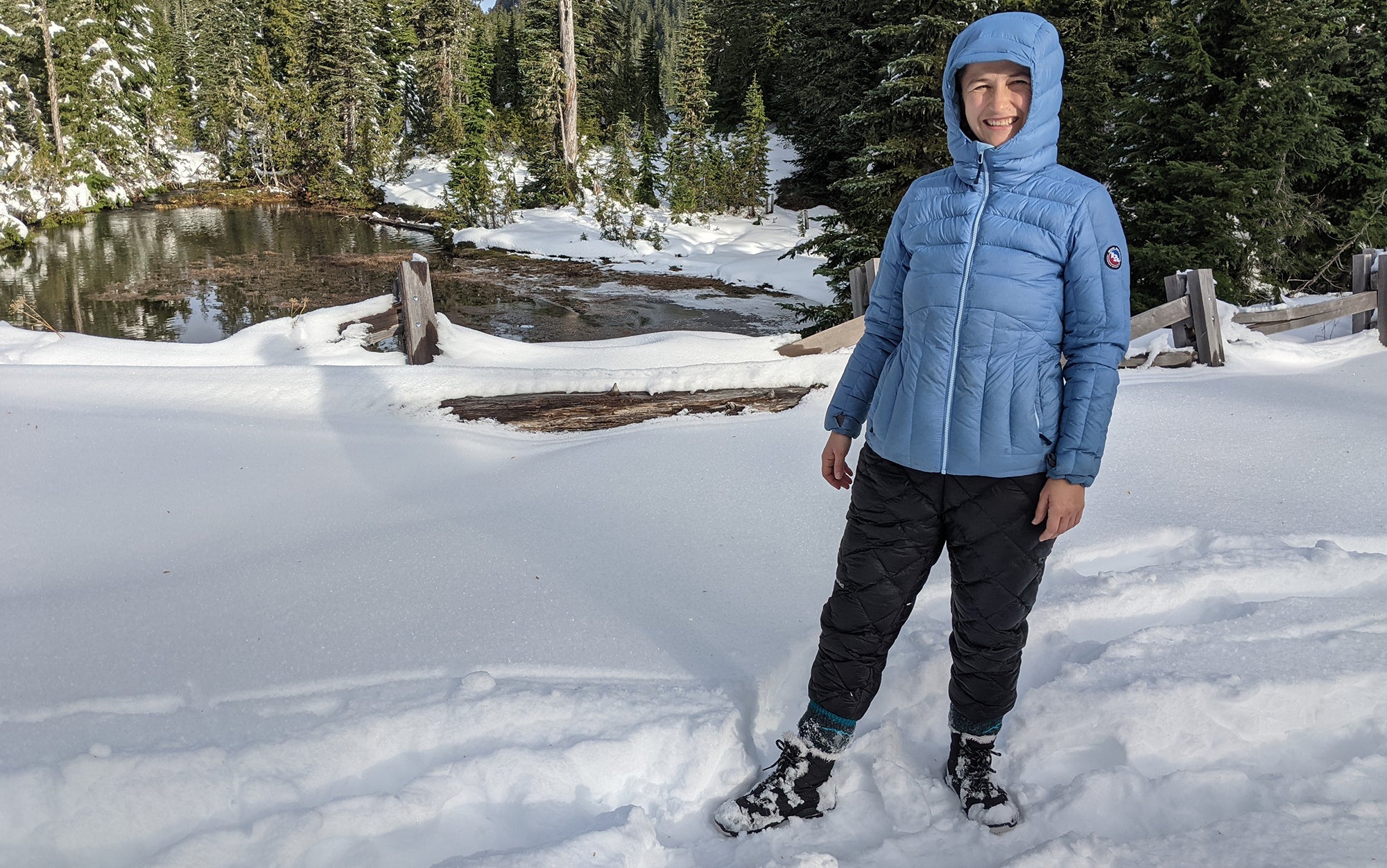
While I looked at a pair of the newest model of the Montbell Light Down Pants for this story, I have a pair in my gear closet that I’ve had for close to a decade—it’s picked up exactly one tiny rip in that time, attesting to these puffers’ overall durability.
Best for Scouting: Kuiu Super Down Ultra Pant
Kuiu
Key Features
- Available Sizes: Men’s M-XXXL
- Weight: 8 ounces
- Fill Power: 850fp
- Fill Weight: 1.7 ounces
- Shell Material: 12D ripstop
Pros
- Lightweight
- Easy to take on and off
- Reinforced at the seat, knees, and cuffs
- Built-in stuff pocket
Cons
- Not enough insulation for extreme temperatures, or for sitting still
- Expensive
The problem with the best puffer pants is that sometimes they work a little too well—if you’re consistently taking off your down pants three minutes into hiking, it might be time to switch to something with a little less fill.
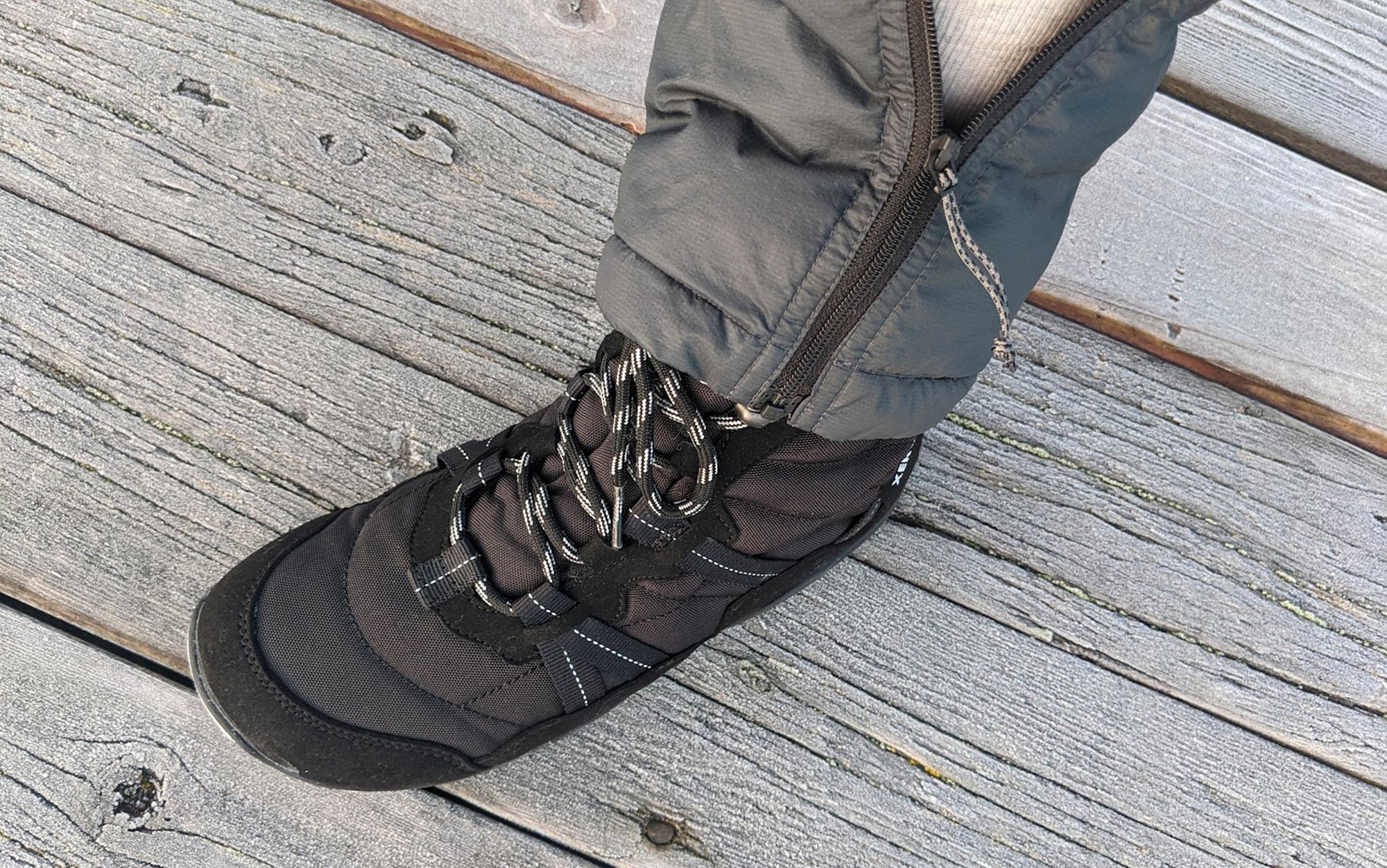
The Kuiu Super Down Ultra Pant hits the sweet spot of performance: better warmth for weight than you’d get out of even the best base layers for hunting (and more packable than fleece) but not so much warmth that you’ll be soaking the down with sweat ten minutes into an uphill climb. It had the lowest fill content of any puffer I looked at (1.7 ounces for an 8-ounce pair), making it appropriate for either early shoulder season conditions or thirty-degree temps when you are on the move. While at first glance it looks like side zips mean you could put on or pull off these puffers without having to take off your shoes, they only unzip from the top to the bottom—you’ll have to unzip these into two separate pieces to take them off in the field without removing your shoes.
While most people choose to wear their puffy pants under other layers of clothing, the KUIU Super Down ULTRA Pant incorporates a thicker 30D nylon at the cuff, knee, and seat for added durability in the event you make this your outer layer.
Best Customization: Goosefeet Gear Down Pants
Goosefeet
Key Features
- Available Sizes: Just about any you can dream of
- Weight: depends on your chosen specifications
- Fill Power: 850fp
- Fill Weight: Customizable
- Shell Material: 8D or 20D
Pros
- Comfortable
- Ability to customize just about everything
- Comparatively inexpensive
Cons
- Simple drawstring closure versus the elastic band of other models
- Five-week lead time
The more time you spend out of doors, the more attuned you get to your exact needs. For a pair of puffer pants, you might have a sense of the exact width and inseam, the exact temperature rating, the features you want, and the ones you don’t. (This goes double for backpack hunters and backpackers.) So if you’ve been scouring this list for a pair of down pants that match what’s in your mind’s eye, then you can stop scrolling here.
While the Goosefeet Gear team sent me a pair of insulated pants to test out—Assistant Editor Ashley Thess took them out into the field and was impressed by how durable and comfortable the 20D nylon was, as well as how warm they were for the weight. However, this configuration isn’t what I would design if I were planning a backpacking trip. For that, I would choose a 20D shell with an 8D liner to save on weight. Next, I would add a pair of 18-inch zips on the side of each leg (Other options include: 24-inch, 30-inch, 36-inch, full-size zips, or full two-way zips, like the Stone Glacier Grumman).
Then you can choose your 850 down fill power weight from 2.5 ounces (early alpine mornings) up to 8.5 ounces (expedition weight). Next, select your waist, hips, inseam (between 20” and 38”), thigh circumference, and calf circumference.
This level of customization is not for everyone, but for serious, weight-conscious adventurers, it’s a must.
Best for Winter: Rab Argon Down Pants
Rab
Key Features
- Available Sizes: Men’s XS-XXL
- Weight: 13.2 ounces
- Fill Power: 800fp
- Fill Weight: 13.2 ounces
- Shell Material: Pertex
Pros
- Seriously warm
- Comparatively affordable
Cons
- Difficult to layer underneath shell layers
- Need to remove shoes to take off
When hunting plans called for getting up well before dawn to sit in a deer blind in 28-degree weather, there was no question which puffer I was going to test: the Rab Argon Down Pants. At 800fp, it didn’t have the highest fill power of the puffers I looked at, but what it lacked in quality, it made up for in sheer quantity. With 5.6 ounces of down packed into its 13.2 ounces, the Rab Argon Down Pants had a bit of the traditional “sausage” look that the puffers of yore were known for. And I was glad of it. With nothing more than a base layer underneath these insulated pants, my legs were honestly warmer than my double-base-layer, down-layer, shell-layer-clad torso.
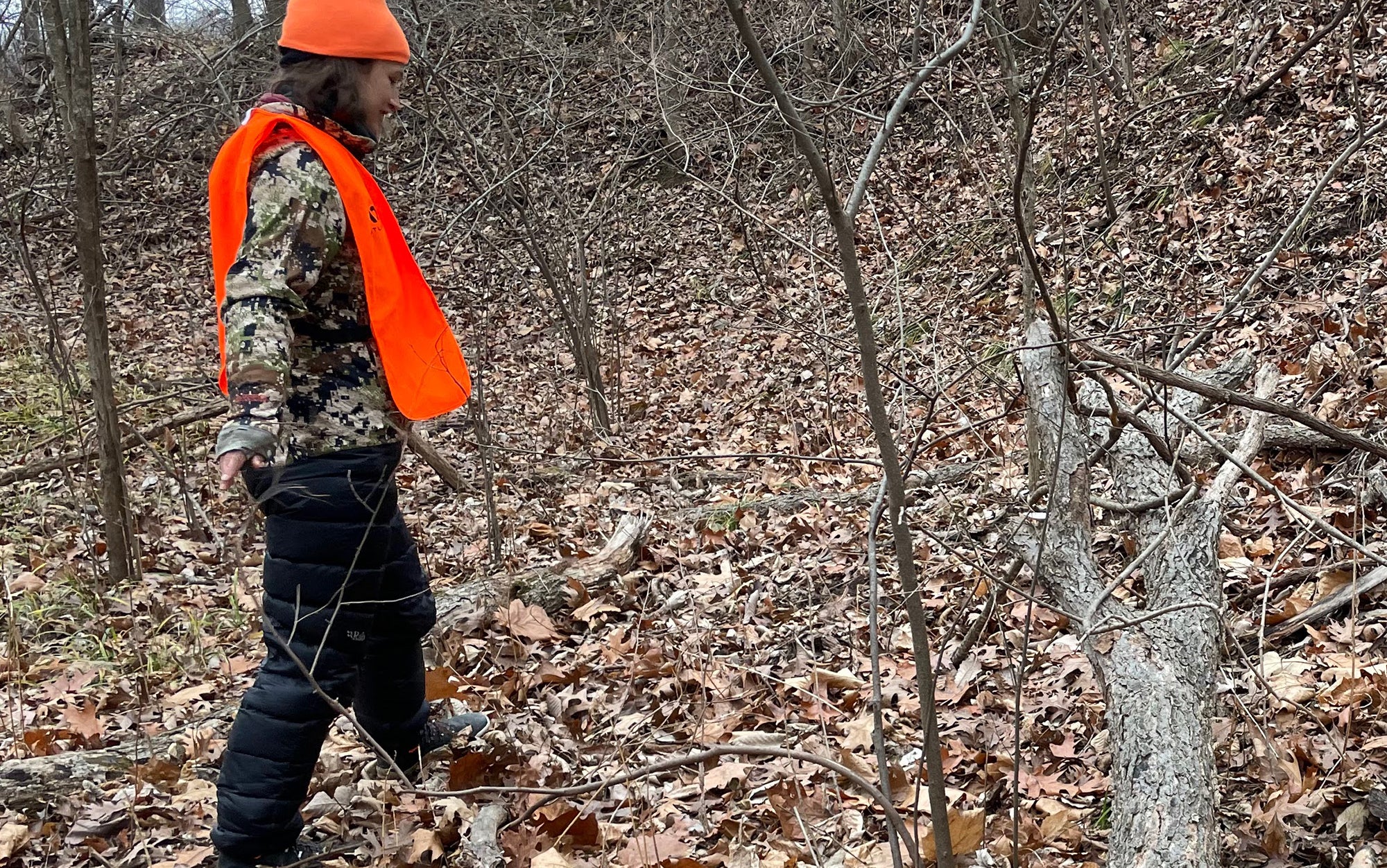
While the Rab Argon aren’t exactly UL, they are extremely lightweight for their performance. The downside of that is that these lacked some of the functionality of other puffers, like the Stone Glacier Grumman. The only on-off-mechanism is a zip, snap-button, and belt at the waist, making it difficult to both moderate your temperature or remove the pants without first taking off your shoes. Snag a pair of these if you plan to be primarily stationary or if you expect unusually cold temperatures.
Best for Hunting: Stone Glacier Grumman Down Pant
Stone Glacier
Key Features
- Available Sizes: Men’s S-XXL
- Weight: 16 ounces
- Fill Power: 800fp
- Fill Weight: 4.2 ounces
- Shell Material: 15D Pertex
Pros
- Warm enough for late shoulder season conditions
- Side zips mean you can take off the Grummans without removing your shoes
Cons
- Heaviest puffer pant I looked at
If you spend enough time outdoors, you eventually get used to all the outfit changes. You start the day, frost on the ground, air steaming with breath, wearing basically everything you have with you: base layers, midlayers, insulation layers—maybe even a shell layer. As the sun rises in the sky, you start to peel off the layers until you’re down to your base layer, everything else dumped into your pack. This gets pretty old after a while, especially if you have to take off your shoes each time you want to shed a layer.
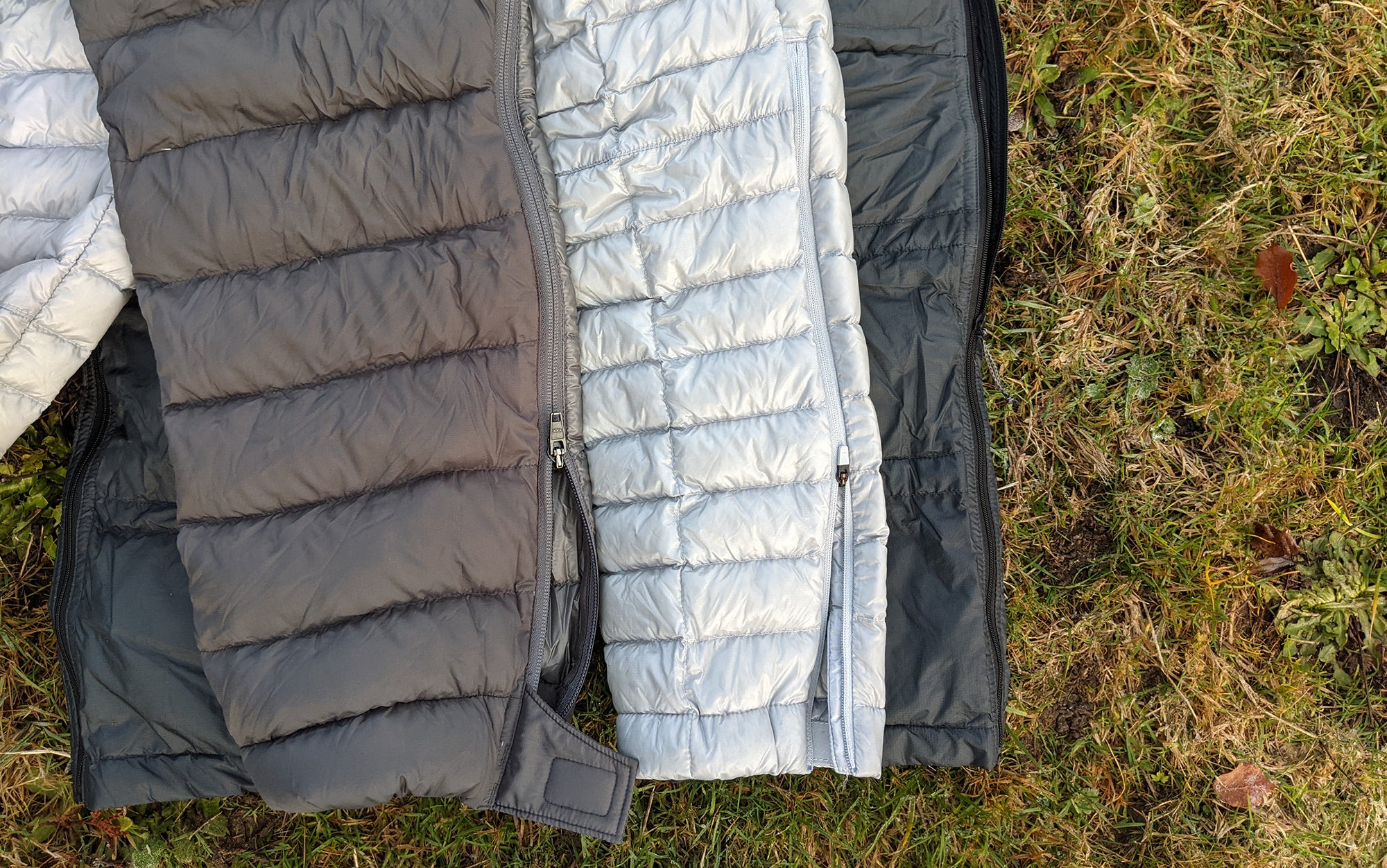
While other puffy pants I looked at incorporated some side zip element, the Stone Glacier Grumman took it one step further: Two zips on each side meant that I could pull down the zips at the top as far as I wanted to easily pull the puffer pants up, while zips at the cuffs made it easy to pull the pants on over my shoes. (In fact, it was so easy that when I did finally start overheating at deer camp, I was able to just discreetly pull them off right where I was sitting). Even better, the Grumman stayed warm even when I wasn’t doing anything more physically exerting than sitting perfectly still in a deer blind, providing plenty of heat for this cold-blooded writer during low-40 temps.
Best Bib: Cotopaxi Fuego Down Overall
Cotopaxi
Key Features
- Available Sizes: Men’s S-XXL
- Weight: 14 ounces
- Fill Power: 800fp
- Fill Weight: Unavailable
- Shell Material: 20D nylon
Pros
- Warm
- Adjustable shoulder straps
- Phone pocket
Cons
- Full side zip only along one side
- Looser fit felt unnecessarily baggy
I was excited to test these down overalls in the runup to ski season. I’m one of those people whose extremities are typically warm as long as my core is warm, but keeping my core warm is sometimes challenging in sub-freezing temps when the wind is whipping. Cotopaxi Fuego overalls sounded like just the ticket to create an even stronger buffer against the cold outside air.
And it did do just that. Pulling on these overalls noticeably increased my overall warmth beyond what I would expect from typical puffer pants. The only downside was that pulling them on was a bit more of a chore than I would have liked. While most puffer pants you can simply pull on like regular pants, the Fuego overalls have a zip running along one leg. To put these on, you have to pull the zip down and then sort of step sideways into them. It’s a bit of an awkward maneuver. And, unlike the Stone Glacier Grummen, the full-length zip was only one side of the pants, so you aren’t able to remove these pants without taking off your boots in most cases. However, that’s a minor ding. If the idea of down overalls appeals to you, then you won’t be disappointed in this purchase.
What to Consider Before Buying Puffer Pants
Insulation
The two main types of insulation are down (sourced from geese, or less commonly, ducks) and synthetic. Each has their own pros and cons.
Down is easily the better insulator and provides more warmth for weight than just about any other material used in outdoor gear. If you look at a down feather, you’ll see that it’s made up of innumerable wisps connected to a short shaft. The lack of structure to these feathers creates small air pockets, which trap heat from your body and insulate it from the cold outside air. Down-feather quality is measured by fill power (fp), or how much down it takes to fill one cubic inch of space. For instance, one ounce of 550fp down will fill about nine liters, while one ounce of 900fp will fill almost 15 liters. The Achilles heel of down feathers has always been moisture. When down gets wet, the pockets of air disappear, eliminating virtually all of its insulating properties. In recent years, manufacturers have started using down feathers treated with a water-resistant coating, sometimes referred to as DownTek, but there are several different names. While the water-resistant coating provides some protection, a soaking-wet down coat will not provide anywhere near the same insulation as a dry one. With down products, it’s also worth checking whether the product is RDS (Responsible Down Standard) certified, which helps ensure that no geese or ducks were unnecessarily harmed (such as live plucking).
The sleeping bags of slumber parties are a good example of synthetic fill. High-end synthetic fill mimics the qualities of down by using short filaments to create pockets that trap body heat. Further, synthetic fill retains heat while wet without the need for additional treatment. The highest quality synthetic fills can approach the insulation-to-weight ratio of 550fp down, but these synthetics also approach the cost of lower quality down. Due to the lower warmth-to-weight-or-size ratio, we did not look at any synthetic puffer pants in this test.
While the fill power measurement is one consideration when looking for the warmest (or lightest) down pants, another is the weight of the fill. The more fill you have, typically the warmer a pair will be. Although, if you are layering your puffers under a tight-fitting shell layer, it can reduce the number of warm air pockets compared to if it was unimpeded.
Shell Material
Down and synthetics are typically encased by nylon of varying thicknesses, which is measured in denier (D). Most insulated pants use fabrics between 10D and 30D.
Closure Mechanisms
There was a surprising amount of variation in how the puffer pants fit at the waist, from a standard zip and button closure, to nothing more than an elastic waist or drawstring closure, to side zips with velcro tabs. Which one is right for you will depend on your needs. If all you care about is the warmth-to-weight ratio, go with the elastic waist or drawstring closure, while if you need your puffers to be easy to take off in the field, choose a model that allows you to zip along the sides to reduce the need to take off the best hiking boots in the field.
Why Trust Outdoor Life?
Since 1898, OL has been a leading authority in testing and reviewing hunting gear, fishing tackle, guns and shooting equipment, and much more. We have more than a century-long history of evaluating products, and we’re now bringing that expertise to online reviews. Our editors are experienced outdoorsmen and women, and most importantly, we’re trained journalists. We prioritize field testing and objective data when reviewing products. We conduct interviews with gear manufacturers and engineers as well as outdoor experts so that our readers have an understanding of how and why a product works—or doesn’t.
Advertising does not influence our gear reviews and it never will. While we always focus our coverage on standout products—because we want our readers to be aware of the latest and greatest gear—we also cover the flaws and quirks of any given product.
Final Thoughts
After testing six pairs of the best puffer pants in a number of environments, including a December Missouri deer hunt and overnight snowshoe trip, the Outdoor Life gear team was able to identify a number of excellent options for different outdoor scenarios. Anyone looking to keep the weight down in their pack should pick up a pair of either the Mountain Hardwear Ghost Whisperer or the ultralight Montbell Light Down Pants. Conversely, individuals facing the coldest conditions (or who just run cold) should snag a pair of either the Rab Argon or Stone Glacier Grumman or customize a pair from Goosefeet Gear to meet their needs.
The post The Best Puffer Pants of 2023: Tested and Reviewed appeared first on Outdoor Life.
Articles may contain affiliate links which enable us to share in the revenue of any purchases made.

